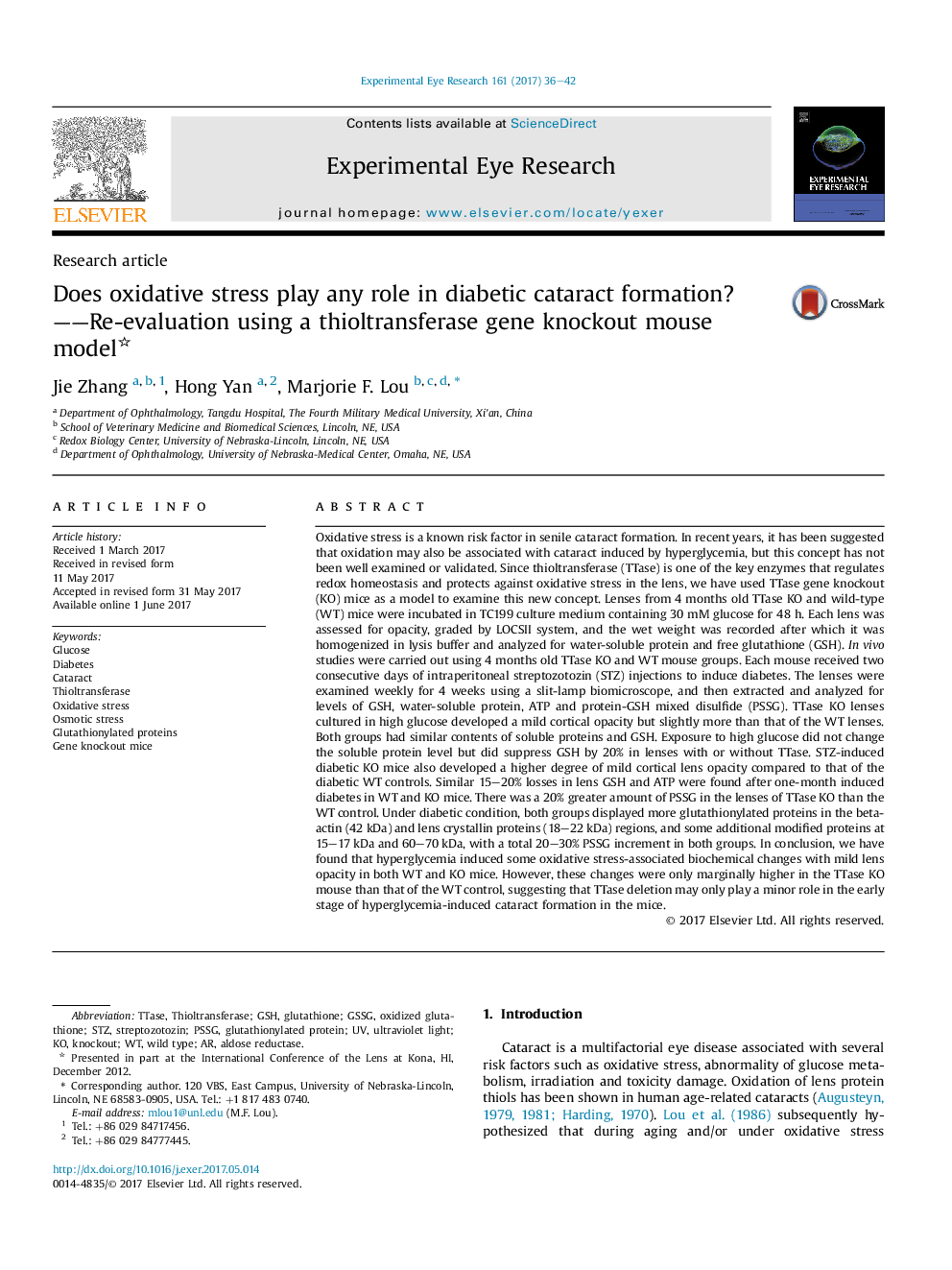| کد مقاله | کد نشریه | سال انتشار | مقاله انگلیسی | نسخه تمام متن |
|---|---|---|---|---|
| 5704012 | 1602561 | 2017 | 7 صفحه PDF | دانلود رایگان |
عنوان انگلیسی مقاله ISI
Does oxidative stress play any role in diabetic cataract formation? ----Re-evaluation using a thioltransferase gene knockout mouse model
ترجمه فارسی عنوان
آیا استرس اکسیداتیو نقش مهمی در شکل گیری کاتاراکت دیابتی ایفا می کند؟ ---- ارزیابی مجدد با استفاده از یک مدل ماوس نایکودن ژن تیلوترانسفراز
دانلود مقاله + سفارش ترجمه
دانلود مقاله ISI انگلیسی
رایگان برای ایرانیان
کلمات کلیدی
PSSGSTZGSHGSSGCataract - آب مرواریدAldose reductase - آلدووز ردوکتازOsmotic stress - استرس اسمزیDiabetes - بیماری قندOxidative stress - تنش اکسیداتیوthioltransferase - تیلوترانسفرازgene knockout mice - موش های نابود کننده ژنknockout - ناکاوتultraviolet light - نور ماوراءبنفش یا نور فرابنفشwild type - نوع وحشیGlutathione - گلوتاتیونoxidized glutathione - گلوتاتیون اکسید شدهGlucose - گلوکز
موضوعات مرتبط
علوم زیستی و بیوفناوری
ایمنی شناسی و میکروب شناسی
ایمونولوژی و میکروب شناسی (عمومی)
چکیده انگلیسی
Oxidative stress is a known risk factor in senile cataract formation. In recent years, it has been suggested that oxidation may also be associated with cataract induced by hyperglycemia, but this concept has not been well examined or validated. Since thioltransferase (TTase) is one of the key enzymes that regulates redox homeostasis and protects against oxidative stress in the lens, we have used TTase gene knockout (KO) mice as a model to examine this new concept. Lenses from 4 months old TTase KO and wild-type (WT) mice were incubated in TC199 culture medium containing 30 mM glucose for 48 h. Each lens was assessed for opacity, graded by LOCSII system, and the wet weight was recorded after which it was homogenized in lysis buffer and analyzed for water-soluble protein and free glutathione (GSH). In vivo studies were carried out using 4 months old TTase KO and WT mouse groups. Each mouse received two consecutive days of intraperitoneal streptozotozin (STZ) injections to induce diabetes. The lenses were examined weekly for 4 weeks using a slit-lamp biomicroscope, and then extracted and analyzed for levels of GSH, water-soluble protein, ATP and protein-GSH mixed disulfide (PSSG). TTase KO lenses cultured in high glucose developed a mild cortical opacity but slightly more than that of the WT lenses. Both groups had similar contents of soluble proteins and GSH. Exposure to high glucose did not change the soluble protein level but did suppress GSH by 20% in lenses with or without TTase. STZ-induced diabetic KO mice also developed a higher degree of mild cortical lens opacity compared to that of the diabetic WT controls. Similar 15-20% losses in lens GSH and ATP were found after one-month induced diabetes in WT and KO mice. There was a 20% greater amount of PSSG in the lenses of TTase KO than the WT control. Under diabetic condition, both groups displayed more glutathionylated proteins in the beta-actin (42 kDa) and lens crystallin proteins (18-22 kDa) regions, and some additional modified proteins at 15-17 kDa and 60-70 kDa, with a total 20-30% PSSG increment in both groups. In conclusion, we have found that hyperglycemia induced some oxidative stress-associated biochemical changes with mild lens opacity in both WT and KO mice. However, these changes were only marginally higher in the TTase KO mouse than that of the WT control, suggesting that TTase deletion may only play a minor role in the early stage of hyperglycemia-induced cataract formation in the mice.
ناشر
Database: Elsevier - ScienceDirect (ساینس دایرکت)
Journal: Experimental Eye Research - Volume 161, August 2017, Pages 36-42
Journal: Experimental Eye Research - Volume 161, August 2017, Pages 36-42
نویسندگان
Jie Zhang, Hong Yan, Marjorie F. Lou,
